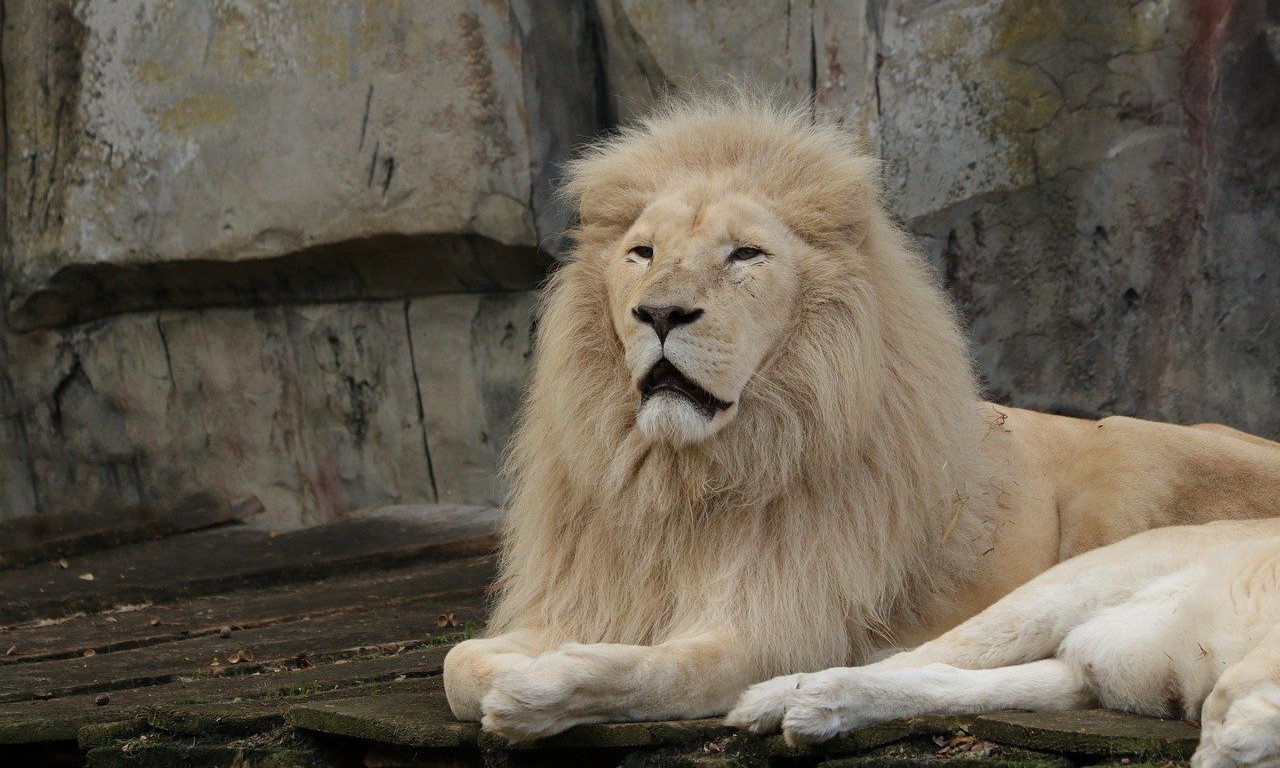White lions are a rare color mutation of the African lion (Panthera leo), characterized by their distinctive pale fur. Their unique appearance is caused by a recessive gene known as leucism, which affects the production of pigment in the skin and fur, resulting in white or pale coloration. Unlike albino animals, white lions retain their normal eye color, ranging from blue to green or gold, and their skin may have a pinkish hue due to reduced melanin production.
White lions are native to the Greater Timbavati region in South Africa, where they were historically revered as sacred animals by local tribes. Due to their rarity and cultural significance, they have become the subject of fascination and conservation efforts around the world. However, their population in the wild is extremely small, with estimates suggesting that only a few dozen individuals remain.
In recent years, white lions have faced numerous threats to their survival, including habitat loss, poaching, and human-wildlife conflict. Conservation organizations and wildlife sanctuaries are working tirelessly to protect and preserve these majestic animals through habitat restoration, anti-poaching initiatives, and public awareness campaigns. Despite the challenges they face, white lions serve as powerful ambassadors for conservation, inspiring efforts to safeguard their future and the biodiversity of their native ecosystems.

Do you want to know more about white lions? Here are 10 interesting facts about white lions to know more about them.
- Rare Color Mutation: White lions are a rare color mutation of the African lion (Panthera leo), characterized by their distinctive pale fur. Their unique appearance is caused by a recessive gene known as leucism, which affects the production of pigment in the skin and fur, resulting in white or pale coloration.
- Native to Timbavati: White lions are native to the Greater Timbavati region in South Africa. Historically, they were revered as sacred animals by local tribes, who saw them as symbols of power, purity, and divine protection.
- Cultural Significance: Due to their rarity and cultural significance, white lions have become the subject of fascination and conservation efforts around the world. They feature prominently in African folklore and mythology, often depicted as mystical beings with special powers.
- Wild Population: The wild population of white lions is extremely small, with estimates suggesting that only a few dozen individuals remain in their natural habitat. They face numerous threats to their survival, including habitat loss, poaching, and human-wildlife conflict.
- Zoological Interest: White lions have captivated the interest of zoos and wildlife parks around the world. They are often bred in captivity for exhibition and conservation purposes, with some facilities specializing in breeding programs aimed at preserving their genetic diversity.
- Normal Eye Color: Unlike albino animals, white lions retain their normal eye color, which can range from blue to green or gold. Their skin may have a pinkish hue due to reduced melanin production.
- Habitat Restoration: Conservation organizations and wildlife sanctuaries are working tirelessly to protect and preserve white lions through habitat restoration, anti-poaching initiatives, and public awareness campaigns. Efforts are underway to secure protected areas where white lions can thrive in their natural environment.
- Conservation Status: White lions are not recognized as a separate subspecies by the International Union for Conservation of Nature (IUCN), but they are considered critically endangered due to their small population size and the threats they face in the wild.
- Symbol of Conservation: White lions serve as powerful ambassadors for conservation, drawing attention to the plight of their species and inspiring efforts to safeguard their future and the biodiversity of their native ecosystems.
- Educational Opportunities: The presence of white lions in captivity provides valuable opportunities for education and research, allowing scientists and conservationists to study their behavior, genetics, and ecological role in greater detail. Through public outreach and education programs, people can learn more about white lions and the importance of protecting their habitat and species diversity.
In the realm of the African savannah, the white lion stands as a beacon of rare beauty and cultural significance. Despite facing daunting challenges in the wild, including habitat loss and human-wildlife conflict, these majestic creatures continue to inspire awe and captivate the hearts of people around the world. As ambassadors for conservation, white lions serve as symbols of hope, reminding us of the urgent need to protect and preserve the delicate balance of nature. Through concerted efforts in habitat restoration, anti-poaching initiatives, and public awareness campaigns, we can ensure that these magnificent animals continue to roam the African wilderness for generations to come, enriching our world with their presence and reminding us of the inherent value of all living beings.



